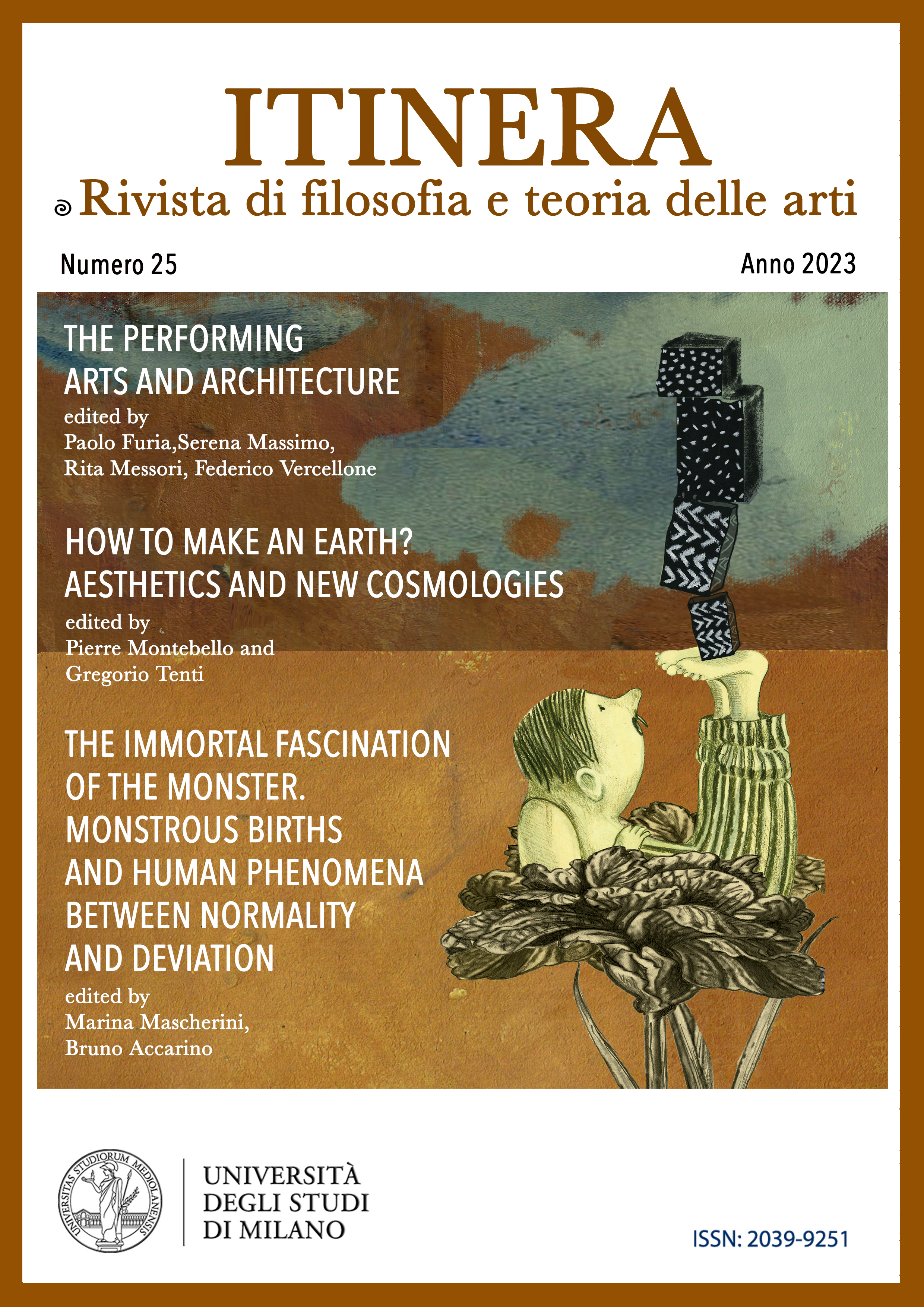Logica delle deviazioni. Dal pensiero magico alla scienza empirica
DOI:
https://doi.org/10.54103/2039-9251/20834Parole chiave:
Anomaly, Tremendus, double monsters, portentuos, error.Abstract
This essay aims to deal with early forms of skepticism, which naturalized the animal Kingdom by removing it from the moral sphere of religious spiritualism.
In the 17th century, the gradual shift from magical thinking to science had important implications in the study of monsters.
Starting from the concept of anomaly, we define a new science of life where monsters dwel. We deal with human phenomena, the tremendus, described and explained as deviations from the norm, errors. In the second half of the 17th century, the most important Academies began to devote themselves to the study of portentuos marvels and the debate on monsters became central in Natural Science: it was during this period that monsters were placed on anatomical tables in order to be dissected and classified. Fundamental in this regard were the studies of the surgeon John Hunter, in whose collection we can admire numerous specimens of so-called double monsters. In the 18th century, thanks to the numerous studies by Étienne Geoffroy Saint-Hilaire and his son Isidore, we arrive at the new vision of monstruosities, finally considered as sufficient in themselves, as autonomous abjects and therefore concrete, accessible and observable. Finally, I will discuss the special relationship between science and spectacle, public an private. The monster embodies a very strong aesthetic end attractive power: the image is the most suitable medium for describing it.
Riferimenti bibliografici
Accarino, B., Zoologia politica. Favole, mostri e macchine, Mimesis, Milano, 2013.
Asma, S. T., On Monsters. An Unnatural History of our Worst Fears, Oxford University Press, Oxford, 2009.
Bory de Saint Vincent, M., Dictionnaire Classique d’Histoire Naturelle, Biodiversity Heritage Library (open access digital library), Paris, 1822.
Canguilhem, G., Il normale e il patologico, trad. it. D. Buzzolan, Einaudi, Torino, 1998.
Daston, L., e Park, K., Le meraviglie del mondo. Mostri, prodigi e fatti strani dal Medioevo all’Illuminismo, trad. it. di M. Ferraro e B. Valotti, Carocci, Roma,1998.
De Vecchi, B., Teratologia generale, Utet, Torino, 1923.
Fadini, U., Negri, A., Wolfe, C. T. (a cura di), Desiderio del mostro. Dal circo al laboratorio alla politica, trad. it. di V. Bianco, G. Nicolemi e S. Talluri, Manifestolibri, Roma, 2001.
Haraway, D., Testimone- modesta@Femaleman- incontra -Oncotopo. Femminismo e tecnoscienza, trad. it. di M. Morganti, Feltrinelli, Milano, 2000.
Kappler, C. C., Demoni, mostri e meraviglie alla fine del Medioevo, a cura di F. Carolini, Jouvence, Milano, 2019.
Klossowsky, P., Il mostro, in G. Bataille, La congiura sacra, trad. it. di F. Di Stefano, Bollati Boringhieri, Torino, 1977 (pp. 8-11).
Le Guyarder, H., Geoffroy Saint-Hilaire. Un Naturaliste Visionnaire, Belin, Paris, 2017.
Mamet, D., Some Freaks, Penguin Grove, New York, 1989.
Mazzocut-Mis, M., Anatomia del mostro. Antologia di scritti di Etienne Geoffroy Saint-Hilaire e Isidore, La Nuova Italia, Firenze, 1995.
Mazzocut-Mis, M., Gli enigmi della forma. Un’indagine morfologica tra biologia ed estetica a partire dal pensiero di D’Arey W. Thompson, CUEM, Milano, 2002.
Mazzocut-Mis, M., Monstre. E. G. Saint-Hilaire and the Science of Monstruosity, in “Medicina nei secoli, arte e scienza”, Journal of History of Medicine, Voll. 26, n. 1, 2014 (pp. 145-165).
Mazzocut-Mis, M., Il mostro. L’anomalo e il deforme nella natura e nell’arte, Ed. Angelo Guerini, Milano, 1992.
Parè, A., Conseiller et Premier Chirurgien du Roy, avec les figures et portraicts tout de Anatomie que es instrument de Chirurgie et de Plusieurs monstres, Chez Gabriel Buon, Paris, 1575.
Saint-Hilaire, G., É., Etudes Progressives d’un Naturaliste pendant les annèes 1834 et 1838, Chez Rorer, Paris, 1835.
Saint-Hilaire, G. É., Philosophie Anatomique. Monstrositès Humaines, J. B. Ballière, Paris, 1772.
Saint-Hilaire, G. I., Essays de zoologie gènèrale, ou Mèmoires et notices sur la Zoologie gènèrale, l’Antropologie et l’Histoire de la science, Rocket, Paris, 1841.
Saint-Hilaire, G. I., Histoire gènèrale des Anomalies et particulière de l’organisation chez les Animaux ou Traitè de Tèratologie, Rey et Gravier, Paris, 1827.
Saint-Hilaire, G. É. et Cuvier, F., Histoire Naturelle des Mammifères, avec des figures originales Enluminèes, desinèes, d’apres desanimaux vivants, M. C. De Lasteyrie Ed., Paris, 1820.
Dowloads
Pubblicato
Versioni
- 2023-10-20 (2)
- 2023-08-08 (1)
Fascicolo
Sezione
Licenza
Copyright (c) 2023 Marina Mascherini

Questo lavoro è fornito con la licenza Creative Commons Attribuzione - Condividi allo stesso modo 4.0.
Gli autori che pubblicano su questa rivista accettano le seguenti condizioni:
1. Gli autori mantengono i diritti sulla loro opera e cedono alla rivista il diritto di prima pubblicazione dell'opera, contemporaneamente licenziata sotto una Licenza Creative Commons - Attribuzione - Condividi allo stesso modo 4.0 internazionale che permette ad altri di condividere l'opera indicando la paternità intellettuale e la prima pubblicazione su questa rivista.
2. Gli autori possono aderire ad altri accordi di licenza non esclusiva per la distribuzione della versione dell'opera pubblicata (es. depositarla in un archivio istituzionale o pubblicarla in una monografia), a patto di indicare che la prima pubblicazione è avvenuta su questa rivista.
3. Gli autori possono diffondere la loro opera online (es. in repository istituzionali o nel loro sito web) prima e durante il processo di submission, poiché può portare a scambi produttivi e aumentare le citazioni dell'opera pubblicata (Vedi The Effect of Open Access).





